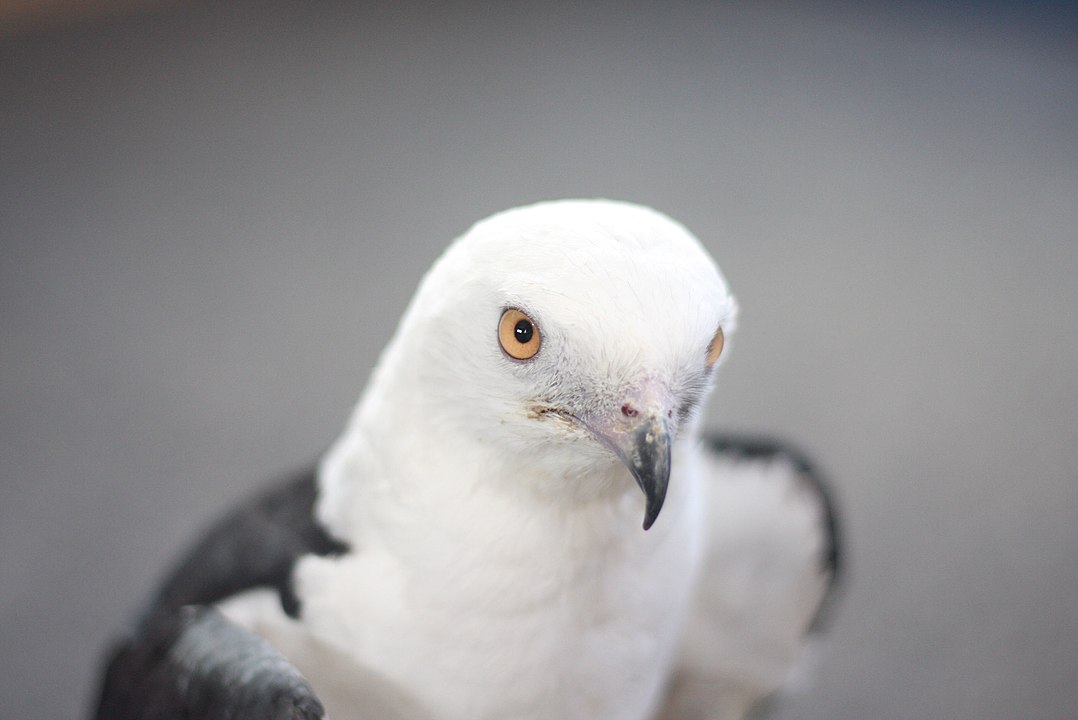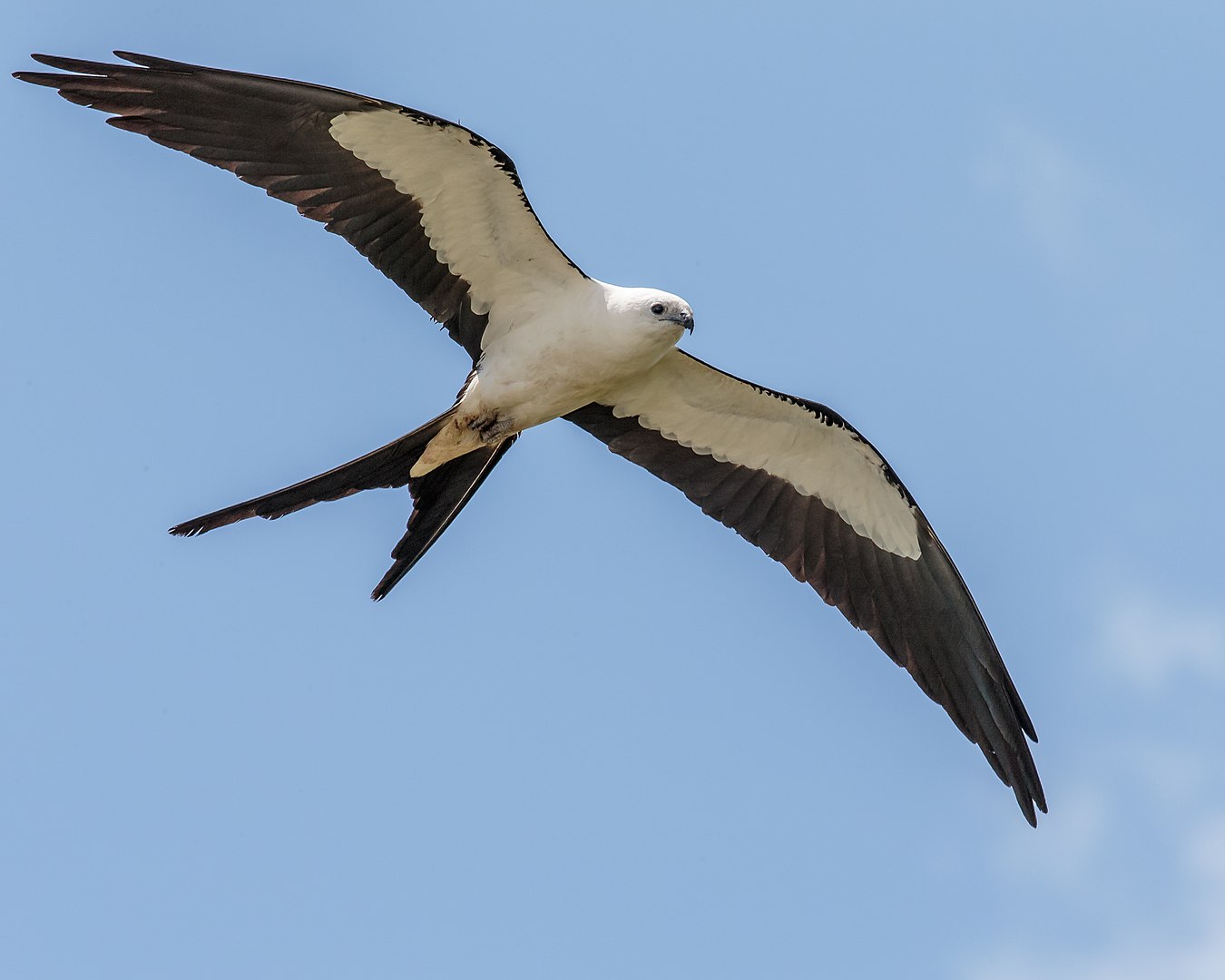The swallow-tailed kite is a graceful, uniquely shaped raptor with long, narrow wings and deeply forked tail. Black-and-white with shining blue-gray upper wing. Usually seen in flight as it soars and glides while twisting its tail. Wingbeats are deep, fluid flaps. Found over a variety of wooded habitats with a preference for wetter habitats around rivers and ponds. It feeds mainly on insects captured on the wing. This article will reveal further details about this marvelous bird.
Features Of The Swallow-tailed Kite
- Color – Male and female individuals appear similar. The body is a contrasting deep black and white. The flight feathers, tail, feet, bill are all black.
- Tail – Another characteristic is the elongated, forked tail at 27.5–37 centimetres (10.8–14.6 in) long, hence the name swallow-tailed.
- Wings – The wings are also relatively elongated, as the wing chord measures 39–45 cm (15–18 in). The tarsus is fairly short for the size of the bird at 3.3 cm (1.3 in).
- Weight & Length – The species is 50 to 68 cm (20 to 27 in) in length, with a wingspan of approximately 1.12–1.36 m (3.7–4.5 ft). The body weight is 310–600 g (11–21 oz).
- Young – Young swallow-tailed kites are duller in color than the adults, and the tail is not as deeply forked.

By AllisonMiller – Own work, CC BY-SA 3.0, https://commons.wikimedia.org/w/index.php?curid=32749290
Scientific Classification Of The Swallow-tailed Kite
Swallow-tailed Kite – Elanoides forficatus [Scientific name]
- Kingdom: Animalia
- Phylum: Chordata
- Class: Aves
- Order: Accipitriformes
- Family: Accipitridae
- Genus: Elanoides (Vieillot, 1818)
- Species: E. forficatus
Habitat Of The Swallow-tailed Kite
The swallow-tailed kite is largely associated with large tracts of wetland forests which accommodates the birds nesting habits. Loblolly pines are the most prevalent choice for building nests but bald cypress (Taxodium distichum) are also used when the pines are unavailable. Nesting locations are often found in trees as high as 100 ft (30 m). Aside from the US, it resides in many areas throughout Central and South America (Guyana).
Diet Of The Swallow-tailed Kite
Swallow-tailed kites hunt on the wing, gleaning prey from deciduous trees, shrubs, and vegetation along rivers, lakes, ponds, marshes, and sloughs. They also feed on small reptiles, such as snakes and lizards. It may also feed on small amphibians such as frogs; large insects, such as grasshoppers, crickets; small birds and eggs; and small mammals including bats. It has been observed to regularly consume fruit in Central America. It drinks by skimming the surface and collecting water in its beak. The bird usually does not break flight during feeding.
Reproduction Of The Swallow-tailed Kite
Mating occurs from March to May, with the female laying 2 to 4 eggs. Incubation lasts 28 days, and 36 to 42 days to fledge. Often thought to form monogamous pairs, the birds are thought to spend some time apart and meet up during migrations to nesting locations. These nesting locations are often found in the highest trees in wetland areas. On occasion, pairs will return to the same nesting locations of the previous years and refurbish old nests. Generally, nests take about four days to complete.
Nest: Swallow-tailed kites build their nests in open woodlands or stands of trees, usually in an exposed site near the top of one of the tallest trees. They generally build a new nest each year, though they may occupy and refurbish an old nest early in the season before abandoning it. Both the male and female bring material to the site and build the nest, a task that they may take a single day or 1 – 2 weeks. Nests are made of small, loosely woven sticks such as cypress or pine, lined with lichens and Spanish moss. They measure 12 – 25 inches across and 5 – 12 inches high, with a flat surface or a shallow cup (up to a few inches deep).
10 Facts About The Swallow-tailed Kite
- The swallow-tailed kite (Elanoides forficatus) is a pernine raptor; it is the only species in the genus Elanoides.
- The birds are considered one of the most graceful fliers seen in America and often spend the majority of their lives scouring high tree tops for lizards, small mammals, and insects.
- The morphology of the swallow-tailed kite’s wing and tail structure allows the bird to glide effortlessly for long distances.
- Sometimes a high-pitched chirp is emitted, though the birds mostly remain silent.
- These birds are creatures of the air, spending most of their day aloft and rarely flapping their wings. They tend to circle fairly low over trees as they hunt for small animals in the branches.
- At times they soar very high in the sky, almost at the limits of vision. During migration they may form large flocks.
- They are very vocal when alarmed or when clashing with other members of their own species. Breeding pairs establish small territories around and above the nest, and maintain them by flying silently in circles above the nest tree. Intruders are chased with loud scolding.
- Multiple pairs may nest near each other in “neighborhoods,” and nonbreeding birds often hang around carrying food and nest materials to breeding females (which reject the gifts).
- Swallow-tailed Kites often roost communally near nests, and right before migration hundreds of kites may roost together.
- To feed young nestlings, the male kite carries a prey item in one or both feet to the nest. There he perches, transfers the food to his beak, and passes it to the female. She tears it up and feeds it to the young. Adults typically consume their food while flying.
Swallow-tailed Kite In Guyana
Yes, the swallow-tailed kite is one of the most beautiful bird of prey, striking in its shape, its pattern, and its extraordinarily graceful flight. Hanging motionless in the air, swooping and gliding, rolling upside down and then zooming high in the air with scarcely a motion of its wings, the swallow-tailed kite is a joy to watch.
Article References:
- https://en.wikipedia.org/wiki/Swallow-tailed_kite
- https://www.allaboutbirds.org/guide/Swallow-tailed_Kite/id
- https://www.allaboutbirds.org/guide/Swallow-tailed_Kite/lifehistory
- https://www.audubon.org/field-guide/bird/swallow-tailed-kite
- https://ebird.org/species/swtkit
- https://iwokrama.org/wp-content/uploads/2018/06/Iwokrama-Bird-Guide-2018-Web-Final.pdf
- Main Image: By Andy Morffew, CC BY 2.0, https://commons.wikimedia.org/w/index.php?curid=61980332







